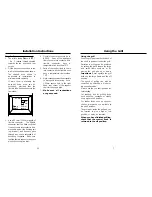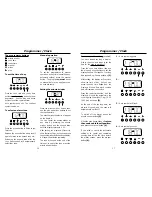
Stainless Steel surfaces
(stainless
steel finish models only)
FACIA PANEL
,
HANDLES
,
DOOR CLADDING
Only use a clean cloth wrung out in hot
soapy water, and dry with a soft cloth.
Stubborn marks can be removed using
“Luneta”. We recommend that you
clean the whole of the stainless steel
area to maintain a uniform finish.
Supplies can be purchased from the
Customer Care Centre.
Do not use undiluted bleach or any
products containing chlorides as they
can permanently damage the steel.
Extra care should be taken when
cooking food in salted water. Some
foods are corrosive - eg; vinegar, fruit
juices and especially
salt
- they can
mark or damage stainless steel if they
are left on the surface. Turn off and
wipe any spillage immediately, taking
care to avoid skin contact with any hot
surface or spillage.
Sharp objects can mark the surface of
stainless steel, but marks will become
less noticeable with time.
To maintain the finish of the stainless
steel, or to remove any greasy marks,
wipe the stainless steel surface
sparingly with a
minimum
amount of
“Johnson’s Baby Oil” and kitchen paper.
Do not use cooking oils, as these may
contain salt, which can damage the
stainless steel surface.
22
Cleaning
Traditional fruit cakes
It should be remembered that ovens
can vary over time, therefore cooking
times can vary, making it difficult to be
precise when baking fruit cakes.
It is necessary, therefore, to test the
cake before removal from the oven.
Use a fine warmed skewer inserted
into the centre of the cake. If the
skewer comes out clean, then the cake
is cooked.
●
Do not attempt to make Christmas
cakes larger than the oven can
cope with; you should allow at
least 25mm (1 inch) space
between the oven walls and the tin.
●
Always follow the temperatures
recommended in the recipe.
●
To protect a very rich fruit cake
during cooking, tin, or tie 2 layers
of brown paper around the tin.
●
We recommend that the cake tin is
not stood on layers of brown
paper, as this can hinder effective
circulation of air.
●
Do not use soft tub margarine for
rich fruit cakes unless specified in
the recipe.
●
Always use the correct size and
shape of tin for the recipe quantities.
Roast turkey
Roasting turkey perfectly involves
cooking two different types of meat -
the delicate light breast meat, which
must not be allowed to dry out, and
the darker leg meat, which takes
longer to cook.
The turkey must be roasted long
enough for the legs to cook, so
frequent basting is necessary. The
breast meat can be covered once
browned.
●
Turkey should be roasted at
gas mark 4 for 20 minutes per
1lb, plus 20 minutes unless
packaging advises otherwise.
●
The turkey can be open roasted,
breast side down, for half of the
cook time, and then turned over for
the remainder of the cooking time.
●
If the turkey is stuffed, add 5
minutes per lb to the cooking time.
●
If roasting turkey covered with
foil, add 5 minutes per 1lb to the
cooking time.
To test if the turkey is cooked, push a
fine skewer into the thickest part of the
thigh. If the juices run clear, the turkey
is cooked. If the juices are still pink,
the turkey will need longer cooking.
11
Using the Oven




































